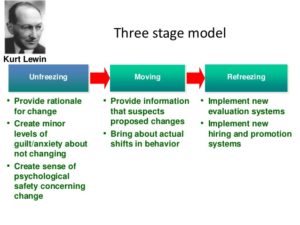Kurt Lewin emigrated from Germany to America during the 1930’s and is recognised as the “founder of social psychology” which highlights his interest in the human aspect of change.
According to Lewin, Change for any individual or an organization is a complicated journey which may not be very simple and mostly involves several stages of transitions or misunderstandings before attaining the stage of equilibrium or stability.
The Kurt Lewin change theory model is based around a 3-step process (Unfreeze-Change-Freeze) that provides a high-level approach to change. It gives a manager or other change agent a framework to implement a change effort, which is always very sensitive and must be made as seamless as possible.

The Kurt Lewin change theory or model can help a leader do the following three steps:
- Make a radical change
- Minimize the disruption of the structure’s operations
- Make sure that the change is adopted permanently
Process of Lewin’s Change Management Model
For explaining the process of organizational change, he used the analogy of how an ice block changes its shape to transform into a cone of ice through the process of unfreezing.

Stage 1 – Unfreezing: This is the first stage of transition and one of the most critical stages in the entire process of change management. It involves improving the readiness as well as the willingness of people to change by fostering a realization for moving from the existing comfort zone to a transformed situation. It involves making people aware of the need for change and improving their motivation for accepting the new ways of working for better results. During this stage, effective communication plays a vital role in getting the desired support and involvement of the people in the change process.
Stage 2 – Change: This stage can also be regarded as the stage of Transition or the stage of actual implementation of change. It involves the acceptance of the new ways of doing things. This is the stage in which the people are unfrozen, and the actual change is implemented. During this stage, careful planning, effective communication and encouraging the involvement of individuals for endorsing the change is necessary. It is believed that this stage of transition is not that easy due to the uncertainties or people are fearful of the consequences of adopting a change process.
Stage 3 – Freeze (Refreezing): During this stage, the people move from the stage of transition (change) to a much more stable state which we can regard as the state of equilibrium. The stage of Refreezing is the ultimate stage in which people accept or internalize the new ways of working or change, accept it as a part of their life and establish new relationships. For strengthening and reinforcing the new behaviour or changes in the way of working, the employees should be rewarded, recognized and provided positive reinforcements, supporting policies or structures can help in reinforcing the transformed ways of working.
